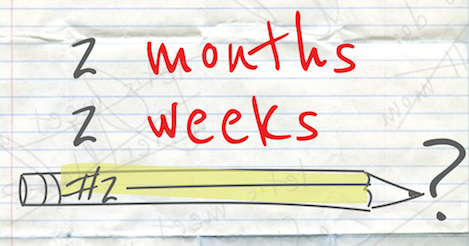Dr. Justine Falcone, Dr. Anand Patel, and Dr. David Delnegro contributed to this post.
Are you wondering about Step 3 format and how to prepare? If so, congratulations! That means you are likely preparing to take the third and final—yes, the END is finally in sight—United States Medical Licensing Exam (USMLE)!
But, you’re also probably curious about what tips you can use to crush it on the big day. Below is some great information on Step 3 format, plus some tricks you can use to put on a stellar performance.
Let’s get started!
1. Remember that the Step 3 exam is two full days!
A basic aspect of Step 3 format is the exam is divided into two parts. The two Step 3 examination days are divided by content, with Day 1 focusing on basic science and Day 2 focusing on clinical science. Although both are part of the same exam, each day requires different sets of skills and preparation to successfully navigate it.
2. Here’s the Step 3 format for each day.
Day 1:
Step 3 format on Day 1 consists of 6 blocks of questions, each consisting of 38-39 questions. You have one hour to complete each block, and will have 45 minutes of break time on test day.
There are approximately 7 hours of testing on Day 1.
Your first day of the Step 3 exam focuses on basic medical and science knowledge, such as ethics, fundamental principles, biostatistics, and medical literature.
This first test day is exclusively multiple-choice and is most similar in content and material to the USMLE Step 2 exam.
There is, however, a unique and sometimes dreaded feature to this part of the test: the scientific abstracts and pharmaceutical advertisements.
Day 2:
Step 3 Day 2 is a 9-hour test day. It has 6 blocks of 30 questions each, followed by 13 cases.
You will encounter a combination of multiple-choice questions and computer-based case scenarios.
Step 3 Day 2 tends to emphasize diagnosis, management, and medical decision making.
You will have 45 minutes to complete each block and 10-20 minutes for each case simulation. You will also have a minimum of 45 minutes for break time.
As you prepare for Step 3 Day 2, I strongly advise that you do many timed practice sessions to ensure your ability to complete all questions in an allotted time.
Hindsight 20/20: Leave the drug-related questions till the very end of the block.
3. Step 3 emphasizes stats.
One must focus on statistics to do well on Step 3. Each block on Day 1 consists of 7-10 statistically-related questions. One should be confident with the interpretation and calculation of topics like positive and negative predictive value, sensitivity, specificity, likelihood ratio, odds ratio, etc.
One should also familiarize him or herself with different study tactics for their strengths, weaknesses and associated biases.
Hindsight 20/20: Review USMLE Step 1 material related to statistics and do as many practice questions as possible.
4. Use UWorld for Step 3 prep.
There are a variety of practice materials available to prepare for the USMLE Step 3 exam. The bottom line is to select a few key resources that work best for you and be consistent with using them.
Similar to the other USMLE exams, UWorld for Step 3 tends to be highly favored in preparing for the breadth of content that one could possibly encounter. Also like the other USMLE exams, question strategy and pacing are important skills to hone for the multiple-choice sections.
UWorld offers an option to purchase further practice cases to prepare for the case scenarios. The USMLE website provides an abundance of information and sample items for exam prep.
Step 3 exam topics are less challenging than UWorld.
Topics tested in UWorld are more detailed and challenging than the actual examination, so do not get discouraged by your score. Going through the questions at least twice is optimal for preparing with UWorld. Additionally, taking assessments will help you more accurately predict your Step 3 score.
If you are using your Step 3 score for fellowship or to apply to residencies, you should optimally be above the 67th percentile. If you are riding the P=MD train, then any UWorld percentile above 30th should be sufficient for you to feel good about the written portion of the exam.
Hindsight 20/20: There is no substitute for doing questions. Do as many practice questions as possible!
5. The CCS make Step 3 challenges even tougher.
As mentioned above, the second test date for Step 3 includes 13 clinical case scenarios (CCS), each lasting 10 to 20 minutes. These require a different thought process to master them. With multiple-choice questions, the end goal is to find the right answer.
However, with these cases, grading includes the method of arriving at the right answer as well as subtleties of patient care. The hardest part are the 10-minute cases, which tend to involve more resuscitation and stabilization than definitive management. This tests your ability to think quickly. I usually saved my breaks before a 10-minute case was coming so I could mentally reset.
Use your common sense when doing cases and always await the result of the initial tests before ordering subsequent studies. Do not be afraid to send the patient home and have them follow up in office for further care.
Hindsight 20/20: Use the real-world clinical skills acquired for this part of the test. Treat the patient as a real patient and not an examination prompt.
Be sure to prepare for CCS cases!
Depending on one’s background, stage of training, and medical specialty, these cases may be one of the more difficult aspects of the exam. It is extremely important to work through several practice cases, and familiarize oneself with the case testing software, well before examination day.
The USMLE provides a free downloadable version of the CCS software as well as a few sample cases. Make sure to do the downloadable sample cases at some point so you can get a feel for the software and the lag involved in the cases.
UWorld is actually not the best practice available here! CCS Cases offers more cases with better software (closer to the real thing) and actual feedback on how you did. We highly recommend it over UWorld.
🧠 Check out our guide on how to prepare for CCS cases!
6. You have to master time management!
Time management is a critical skill to have as a physician, regardless of the stage of training. This skill is especially important when preparing for Step 3.
The majority of students take Step 3 when they are already in residency. This means that most people will have to study for Step 3 in addition to a full work schedule. While students may have had the luxury of taking weeks off solely to study for the Step 1 and 2 exams, this is highly unlikely to be the case for Step 3.
Most residents will work full days, nights, and weekends and still be expected to study for Step 3 on top of an already heavy workload. For that reason, time management and planning are crucial.
Schedule Step 3 well in advance so you have time to study.
Plan when to take the exam well in advance, so you make sure there is ample time to study and prepare for the unique challenges posed by Step 3 format. Some residents take the exam during a lighter month of residency (such as during an elective/consult month or during a time when one might have no or little call) to possibly allow more nights, weekends, and days off to study.
Regardless of one’s schedule, it is important to set aside regular study time for Step 3 and hold oneself accountable to a schedule in order to be best prepared on test day.
👀 Looking for more personalized support? Get a free consultation for Step 3 tutoring (+29 average Step 3 score increase)!
7. The Step 3 format allows you to use your breaks!
Do not be in a rush to finish the exam early. Each block is gruesome and requires a lot of mental endurance to be focused throughout. Plenty of break time is allotted throughout the exam, so take a few minutes between each block to refresh your mind. Plan one longer break for food and other necessities.
Always keep time in perspective and know that one block is just one block and does not make or break the exam. This exam is definitely a marathon and not a sprint.
Hindsight 20/20: Take a mini break between each session even if it’s just 2 minutes to clear your head. Plan your breaks before test day, but be flexible enough to change it up based on the feel of the exam.
Why is Step 3 important anyway?
Since most people take Step 3 while already in residency, this may alleviate some pressure (since then the score clearly can’t be used in admittance to residency). However, Step 3 is still a highly important exam.
Most institutions require students/residents to pass it before being able to advance to a certain year of residency. Successful passing of Step 3 is also a requirement of most medical boards, and the score could be used for admission into competitive fellowship programs.
For complete information on the USMLE Step 3 format, as well as sample questions and content, be sure to review the USMLE website.
Looking for more Step 3 help? Check out these other posts on the Blueprint blog:





